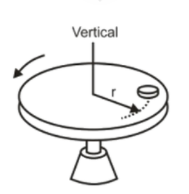A gramophone disc rotates at 60 rpm . A coin of mass 18 g is placed at a distance of 8 cm from the centre . Calculate centrifugal force on the coin . Take π2=9.87 .
To solve the problem of calculating the centrifugal force on a coin placed on a gramophone disc, we can follow these steps:
1. Convert the given mass to kilograms:
The mass of the coin is given as 18 grams. To convert this to kilograms:
m=18 g1000=0.018 kg
2. Convert the distance from centimeters to meters:
The distance from the center of the disc to the coin is given as 8 cm. To convert this to meters:
r=8 cm100=0.08 m
3. Convert revolutions per minute to radians per second:
The disc rotates at 60 revolutions per minute (rpm). To find the angular velocity in radians per second, we use the formula:
ω=2πn
where n is the number of revolutions per second. First, convert rpm to rps:
n=60 rpm60=1 rps
Now, calculate ω:
ω=2π⋅1=2π rad/s
4. Calculate ω2:
We need to square the angular velocity:
ω2=(2π)2=4π2
5. Substitute the value of π2:
We are given π2=9.87, so:
ω2=4⋅9.87=39.48
6. Calculate the centrifugal force:
The formula for centrifugal force Fc is given by:
Fc=mω2r
Substituting the values we have:
Fc=0.018 kg⋅39.48⋅0.08 m
7. Perform the calculation:
Fc=0.018⋅39.48⋅0.08=0.0568512 N
Rounding this to two decimal places gives:
Fc≈0.06 N
Final Answer:
The centrifugal force on the coin is approximately 0.06 N.
The mass of the coin is given as 18 grams. To convert this to kilograms:
m=18 g1000=0.018 kg
The distance from the center of the disc to the coin is given as 8 cm. To convert this to meters:
r=8 cm100=0.08 m
The disc rotates at 60 revolutions per minute (rpm). To find the angular velocity in radians per second, we use the formula:
ω=2πn
where n is the number of revolutions per second. First, convert rpm to rps:
n=60 rpm60=1 rps
Now, calculate ω:
ω=2π⋅1=2π rad/s
We need to square the angular velocity:
ω2=(2π)2=4π2
We are given π2=9.87, so:
ω2=4⋅9.87=39.48
The formula for centrifugal force Fc is given by:
Fc=mω2r
Substituting the values we have:
Fc=0.018 kg⋅39.48⋅0.08 m
Fc=0.018⋅39.48⋅0.08=0.0568512 N
Rounding this to two decimal places gives:
Fc≈0.06 N
The centrifugal force on the coin is approximately 0.06 N.
Topper's Solved these Questions
- CIRCULAR MOTIONBook:DC PANDEY ENGLISHChapter:CIRCULAR MOTIONExercise:Solved Examples
Explore 2 Videos
- CIRCULAR MOTIONBook:DC PANDEY ENGLISHChapter:CIRCULAR MOTIONExercise:Miscellaneous Examples
Explore 5 Videos
- CENTRE OF MASS, LINEAR MOMENTUM AND COLLISIONBook:DC PANDEY ENGLISHChapter:CENTRE OF MASS, LINEAR MOMENTUM AND COLLISIONExercise:Level 2 Subjective
Explore 21 Videos
- COMMUNICATION SYSTEMBook:DC PANDEY ENGLISHChapter:COMMUNICATION SYSTEMExercise:Only One Option is Correct
Explore 27 Videos
Similar Questions
A disc starts rotating with a constant angular acceleration of 1rad/s2 about a fixed vertical axis perpendicular to its plane and passing through its centre. A coin of mass 10gm is placed on the disc at a distance of 10cm from the axis. The coefficent of friction between the disc and the coin is 0.2. The value of the frictional force on the coin at t=1s will be
View SolutionA gramophone record is revolving with an angular velocity ω. A coin is placed at a distance R from the centre of the record. The static coefficient of friction is μ. The coin will revolve with the record if
View SolutionA small coin of mass 40 g is placed on the horizontal surface of a rotating disc. The disc starts from rest and is given a constant angular acceleration α=2 rad s−2. The coefficient of static friction between the coin and the disc is μs=3/4 and the coefficient of kinetic friction is μk=0.5. The coin is placed at a distance r=1m from the centre of the disc. The magnitude of the resultant force on the coin exerted by the disc just before it starts slipping on the disc is?

View SolutionA small coin of mass 80g is placed on the horizontal surface of a rotating disc. The disc starts from rest and is given a constant angular acceleration α=2rad/s2. The coefficient of static friction between the coin and the disc is μs=3/4 and cofficient of kinetic friction is μk=0.5. The coin is placed at a distance r=1m from the centre of the disc. The magnitude of the resultant force on the coin exerted by the disc just before it starts slipping on the disc is

View SolutionA small coin of mass 80g is placed on the horizontal surface of a rotating disc. The disc starts from rest and is given a constant angular acceleration α=2rad/s2. The coefficient of static friction between the coin and the disc is μs=3/4 and cofficient of kinetic friction is μk=0.5. The coin is placed at a distance r=1m from the centre of the disc. The magnitude of the resultant force on the coin exerted by the disc just before it starts slipping on the disc is

View SolutionA coin placed on a rotating turntable just slips if it is placed at a distance of 4 cm from the centre. If the angular velocity of the turntable is doubled, it will just slip at a distance of
View SolutionDraw a circle of radius 2.5cm. Take a point P at a distance of 8 cm from its centre. Construct a pair of tangents from the point P to the circle.
View SolutionDraw a circle of radius 2.5cm. Take a point P at a distance of 8 cm from its centre. Construct a pair of tangents from the point P to the circle.
View SolutionA small coin of mass 5 g is placed at a distance 5 cm from centre on a flat horizontal turn table. The turn table is observed to make 3 revolutions in √10s. The frictional force on the coin is (n×10−3)N. Find value of n.
View SolutionA coin is kept at distance of 10 cm from the centre of a circular turn table. If μ=0.8 the frequency of rotation at which the coin just begins to slip is
View Solution